十二五规划纲要英文版
- 格式:pdf
- 大小:649.40 KB
- 文档页数:74
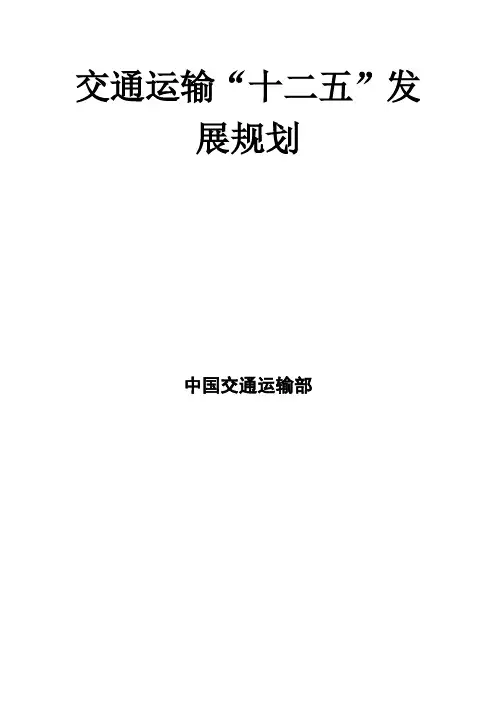
交通运输“十二五”发展规划中国交通运输部目录前言 (1)第一章指导思想和发展目标 (1)第一节发展需求 (1)第二节指导思想和基本原则 (3)第三节发展目标 (4)第二章综合运输 (7)第一节强化基础设施优化衔接 (7)第二节促进现代物流发展 (8)第三节加强城市客运管理 (9)第四节提高综合运输服务保障能力 (10)第三章公路交通 (11)第一节完善公路交通网络 (11)第二节加强公路养护管理 (13)第三节提升公路运输服务水平 (14)第四节完善公路市场管理 (15)第四章水路交通 (16)第一节有序推进沿海港口建设 (16)第二节加快发展内河水运 (17)第三节提升水运服务能力和水平 (19)第四节加强水运市场管理 (20)第五章民用航空 (20)第一节增强机场保障能力 (21)第二节建设现代空管服务系统 (22)第三节提高民航服务能力 (23)第四节加快发展通用航空 (24)第五节确保航空持续安全 (25)第六章邮政业 (26)第一节完善邮政普遍服务体系 (26)第二节构建快递服务体系 (27)第三节加强邮政行业管理 (28)第四节促进交通邮政协同发展 (28)第七章交通科技与信息化 (29)第一节推进科技进步 (29)第八章绿色交通 (33)第一节强化节能减排 (33)第二节节约集约利用资源 (35)第三节加强生态保护和污染治理 (36)第四节加强节能环保监管 (36)第九章安全与应急保障 (37)第一节加强安全生产管理 (37)第二节加强交通安全监管体系建设 (38)第三节加强交通运输应急体系建设 (39)第十章保障措施 (40)第一节加强组织领导,强化规划的指导性 (40)第二节加强资金保障,完善投融资政策 (41)第三节加强法规体系建设,深化体制机制改革 (41)第四节加强人才队伍建设,提供人才保障和智力支持 (42)第五节加强精神文明建设,提升行业发展软实力 (43)附表交通运输“十二五”发展指标汇总 (44)交通运输“十二五”发展规划前言“十二五”时期,我国经济社会发展将进入一个新的历史阶段,交通运输也将进入新的发展时期,依据《中共中央关于制定国民经济和社会发展第十二个五年规划的建议》和《国民经济和社会发展第十二个五年规划纲要》,根据国务院批准交通运输部的职责和工作要求,我部组织编制了《交通运输“十二五”发展规划》(以下简称《规划》)。
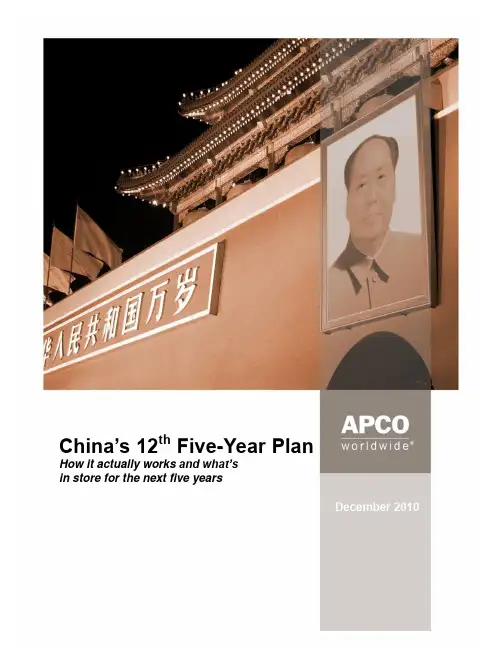
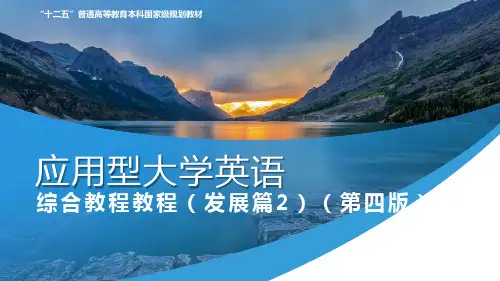
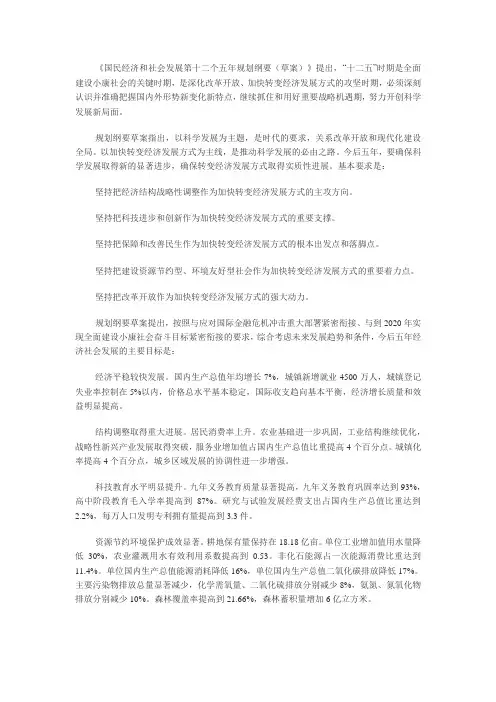
《国民经济和社会发展第十二个五年规划纲要(草案)》提出,“十二五”时期是全面建设小康社会的关键时期,是深化改革开放、加快转变经济发展方式的攻坚时期,必须深刻认识并准确把握国内外形势新变化新特点,继续抓住和用好重要战略机遇期,努力开创科学发展新局面。
规划纲要草案指出,以科学发展为主题,是时代的要求,关系改革开放和现代化建设全局。
以加快转变经济发展方式为主线,是推动科学发展的必由之路。
今后五年,要确保科学发展取得新的显著进步,确保转变经济发展方式取得实质性进展。
基本要求是:坚持把经济结构战略性调整作为加快转变经济发展方式的主攻方向。
坚持把科技进步和创新作为加快转变经济发展方式的重要支撑。
坚持把保障和改善民生作为加快转变经济发展方式的根本出发点和落脚点。
坚持把建设资源节约型、环境友好型社会作为加快转变经济发展方式的重要着力点。
坚持把改革开放作为加快转变经济发展方式的强大动力。
规划纲要草案提出,按照与应对国际金融危机冲击重大部署紧密衔接、与到2020年实现全面建设小康社会奋斗目标紧密衔接的要求,综合考虑未来发展趋势和条件,今后五年经济社会发展的主要目标是:经济平稳较快发展。
国内生产总值年均增长7%,城镇新增就业4500万人,城镇登记失业率控制在5%以内,价格总水平基本稳定,国际收支趋向基本平衡,经济增长质量和效益明显提高。
结构调整取得重大进展。
居民消费率上升。
农业基础进一步巩固,工业结构继续优化,战略性新兴产业发展取得突破,服务业增加值占国内生产总值比重提高4个百分点。
城镇化率提高4个百分点,城乡区域发展的协调性进一步增强。
科技教育水平明显提升。
九年义务教育质量显著提高,九年义务教育巩固率达到93%,高中阶段教育毛入学率提高到87%。
研究与试验发展经费支出占国内生产总值比重达到2.2%,每万人口发明专利拥有量提高到3.3件。
资源节约环境保护成效显著。
耕地保有量保持在18.18亿亩。
单位工业增加值用水量降低30%,农业灌溉用水有效利用系数提高到0.53。

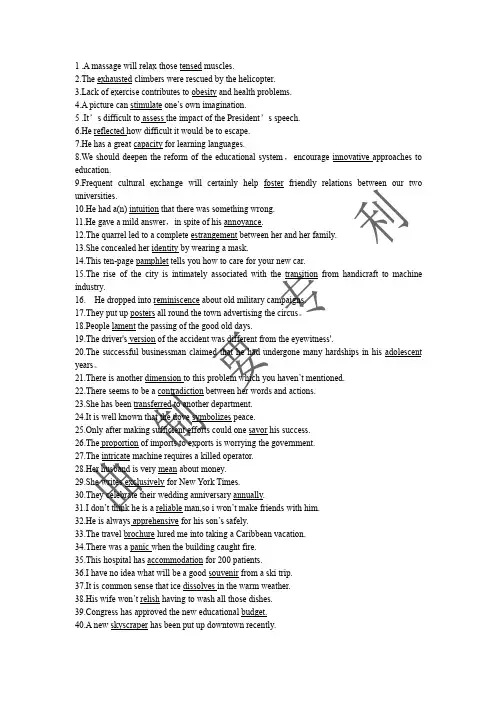
1.A massage will relax those tensed muscles.2.The exhausted climbers were rescued by the helicopter.ck of exercise contributes to obesity and health problems.4.A picture can stimulate one’s own imagination.5.It’s difficult to assess the impact of the President’s speech.6.He reflected how difficult it would be to escape.7.He has a great capacity for learning languages.8.We should deepen the reform of the educational system,encourage innovative approaches to education.9.Frequent cultural exchange will certainly help foster friendly relations between our two universities.10.He had a(n)intuition that there was something wrong.11.He gave a mild answer,in spite of his annoyance.12.The quarrel led to a complete estrangement between her and her family.13.She concealed her identity by wearing a mask.14.This ten-page pamphlet tells you how to care for your new car.15.The rise of the city is intimately associated with the transition from handicraft to machine industry.16.He dropped into reminiscence about old military campaigns.17.They put up posters all round the town advertising the circus。
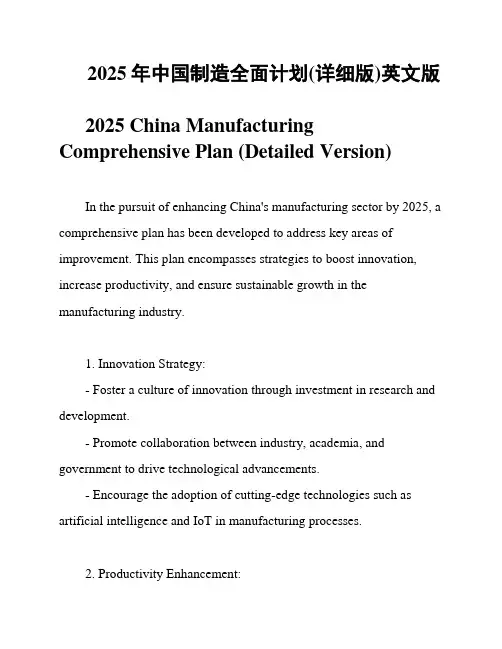
2025年中国制造全面计划(详细版)英文版2025 China Manufacturing Comprehensive Plan (Detailed Version)In the pursuit of enhancing China's manufacturing sector by 2025, a comprehensive plan has been developed to address key areas of improvement. This plan encompasses strategies to boost innovation, increase productivity, and ensure sustainable growth in the manufacturing industry.1. Innovation Strategy:- Foster a culture of innovation through investment in research and development.- Promote collaboration between industry, academia, and government to drive technological advancements.- Encourage the adoption of cutting-edge technologies such as artificial intelligence and IoT in manufacturing processes.2. Productivity Enhancement:- Implement lean manufacturing practices to streamline production processes and reduce waste.- Invest in automation and robotics to improve efficiency and reduce labor costs.- Enhance supply chain management to ensure timely delivery of materials and components.3. Sustainable Growth Initiatives:- Implement green manufacturing practices to reduce carbon emissions and minimize environmental impact.- Promote the use of renewable energy sources in manufacturing operations.- Adopt circular economy principles to reduce waste and promote resource efficiency.4. Talent Development:- Invest in vocational training programs to upskill the workforce and meet the demands of a rapidly evolving industry.- Encourage lifelong learning and professional development among manufacturing professionals.- Attract top talent through competitive salaries, benefits, and career advancement opportunities.5. Market Expansion:- Explore new markets and opportunities for export growth in emerging economies.- Strengthen partnerships with global companies to enhance competitiveness on the international stage.- Develop innovative marketing strategies to promote Chinese manufactured products to a wider audience.6. Regulatory Compliance:- Ensure compliance with international standards and regulations to maintain quality and safety standards.- Stay abreast of industry trends and regulations to anticipate changes and adapt accordingly.- Collaborate with regulatory bodies to address any compliance issues and ensure a smooth transition.By implementing these strategies and initiatives, China aims to become a global leader in manufacturing by 2025, driving economic growth and innovation in the industry.。
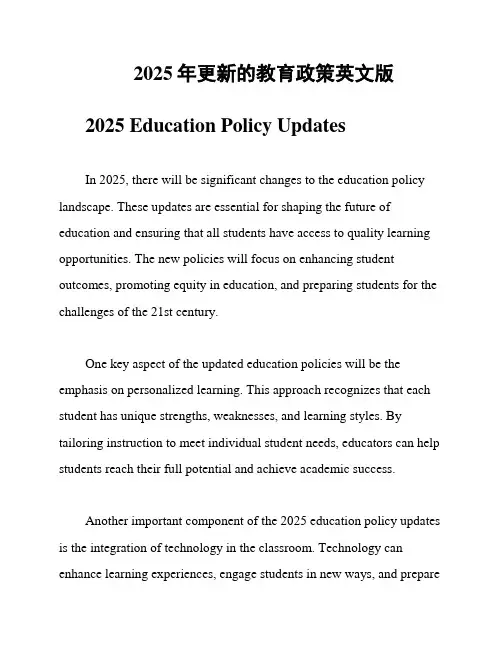
2025年更新的教育政策英文版2025 Education Policy UpdatesIn 2025, there will be significant changes to the education policy landscape. These updates are essential for shaping the future of education and ensuring that all students have access to quality learning opportunities. The new policies will focus on enhancing student outcomes, promoting equity in education, and preparing students for the challenges of the 21st century.One key aspect of the updated education policies will be the emphasis on personalized learning. This approach recognizes that each student has unique strengths, weaknesses, and learning styles. By tailoring instruction to meet individual student needs, educators can help students reach their full potential and achieve academic success.Another important component of the 2025 education policy updates is the integration of technology in the classroom. Technology can enhance learning experiences, engage students in new ways, and preparethem for the digital world they will enter upon graduation. By incorporating technology into the curriculum, students can develop essential digital literacy skills and stay competitive in the global economy.In addition to personalized learning and technology integration, the 2025 education policies will also prioritize teacher professional development. Educators play a crucial role in student success, and it is essential that they have the support and resources they need to excel in their roles. By investing in teacher training and ongoing professional development, schools can ensure that their staff are equipped to deliver high-quality instruction and support student learning effectively.Furthermore, the updated education policies will address issues of equity and access in education. It is essential that all students have equal opportunities to learn and succeed, regardless of their background or circumstances. The new policies will aim to reduce disparities in educational outcomes and ensure that every student has access to high-quality instruction, resources, and support.Overall, the 2025 education policy updates are designed to create a more inclusive, innovative, and effective education system. By focusing on personalized learning, technology integration, teacher professional development, and equity in education, policymakers can help students thrive and prepare them for the challenges and opportunities of the future.。
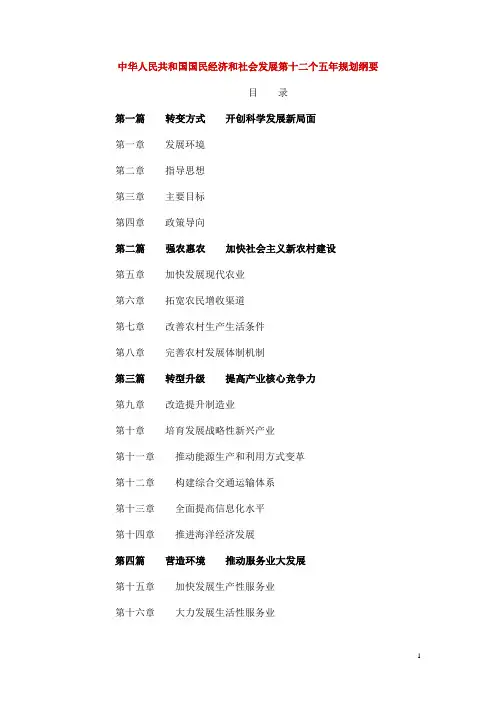
中华人民共和国国民经济和社会发展第十二个五年规划纲要目录第一篇转变方式开创科学发展新局面第一章发展环境第二章指导思想第三章主要目标第四章政策导向第二篇强农惠农加快社会主义新农村建设第五章加快发展现代农业第六章拓宽农民增收渠道第七章改善农村生产生活条件第八章完善农村发展体制机制第三篇转型升级提高产业核心竞争力第九章改造提升制造业第十章培育发展战略性新兴产业第十一章推动能源生产和利用方式变革第十二章构建综合交通运输体系第十三章全面提高信息化水平第十四章推进海洋经济发展第四篇营造环境推动服务业大发展第十五章加快发展生产性服务业第十六章大力发展生活性服务业第十七章营造有利于服务业发展的环境第五篇优化格局促进区域协调发展和城镇化健康发展第十八章实施区域发展总体战略第十九章实施主体功能区战略第二十章积极稳妥推进城镇化第六篇绿色发展建设资源节约型、环境友好型社会第二十一章积极应对全球气候变化第二十二章加强资源节约和管理第二十三章大力发展循环经济第二十四章加大环境保护力度第二十五章促进生态保护和修复第二十六章加强水利和防灾减灾体系建设第七篇创新驱动实施科教兴国战略和人才强国战略第二十七章增强科技创新能力第二十八章加快教育改革发展第二十九章造就宏大的高素质人才队伍第八篇改善民生建立健全基本公共服务体系第三十章提升基本公共服务水平第三十一章实施就业优先战略第三十二章合理调整收入分配关系第三十三章健全覆盖城乡居民的社会保障体系第三十四章完善基本医疗卫生制度第三十五章提高住房保障水平第三十六章全面做好人口工作第九篇标本兼治加强和创新社会管理第三十七章创新社会管理体制第三十八章强化城乡社区自治和服务功能第三十九章加强社会组织建设第四十章完善维护群众权益机制第四十一章加强公共安全体系建设第十篇传承创新推动文化大发展大繁荣第四十二章提高全民族文明素质第四十三章推进文化创新第四十四章繁荣发展文化事业和文化产业第十一篇改革攻坚完善社会主义市场经济体制第四十五章坚持和完善基本经济制度第四十六章推进行政体制改革第四十七章加快财税体制改革第四十八章深化金融体制改革第四十九章深化资源性产品价格和环保收费改革第十二篇互利共赢提高对外开放水平第五十章完善区域开放格局第五十一章优化对外贸易结构第五十二章统筹“引进来”与“走出去”第五十三章积极参与全球经济治理和区域合作第十三篇发展民主推进社会主义政治文明建设第五十四章发展社会主义民主政治第五十五章全面推进法制建设第五十六章加强反腐倡廉建设第十四篇深化合作建设中华民族共同家园第五十七章保持香港澳门长期繁荣稳定第五十八章推进两岸关系和平发展和祖国统一大业第十五篇军民融合加强国防和军队现代化建设第五十九章加强国防和军队现代化建设第六十章推进军民融合式发展第十六篇强化实施实现宏伟发展蓝图第六十一章完善规划实施和评估机制第六十二章加强规划协调管理(责任编辑:张少雷)中华人民共和国国民经济和社会发展第十二个五年规划纲要(全文)中华人民共和国国民经济和社会发展第十二个五年(2011-2015年)规划纲要,根据《中共中央关于制定国民经济和社会发展第十二个五年规划的建议》编制,主要阐明国家战略意图,明确政府工作重点,引导市场主体行为,是未来五年我国经济社会发展的宏伟蓝图,是全国各族人民共同的行动纲领,是政府履行经济调节、市场监管、社会管理和公共服务职责的重要依据。
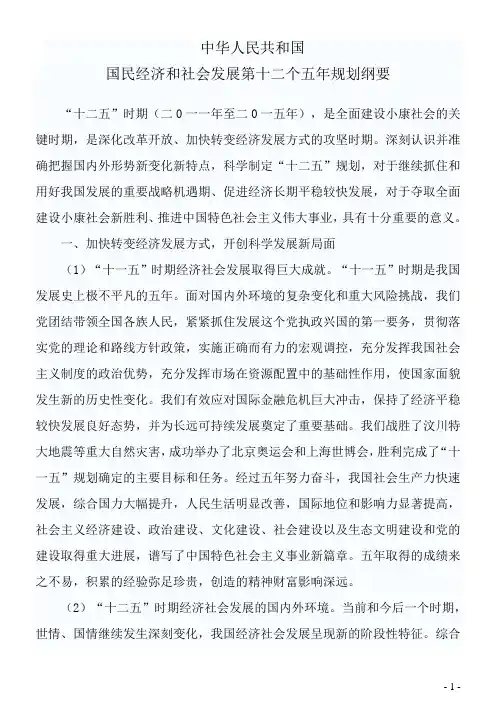
中华人民共和国国民经济和社会发展第十二个五年规划纲要“十二五”时期(二0一一年至二0一五年),是全面建设小康社会的关键时期,是深化改革开放、加快转变经济发展方式的攻坚时期。
深刻认识并准确把握国内外形势新变化新特点,科学制定“十二五”规划,对于继续抓住和用好我国发展的重要战略机遇期、促进经济长期平稳较快发展,对于夺取全面建设小康社会新胜利、推进中国特色社会主义伟大事业,具有十分重要的意义。
一、加快转变经济发展方式,开创科学发展新局面(1)“十一五”时期经济社会发展取得巨大成就。
“十一五”时期是我国发展史上极不平凡的五年。
面对国内外环境的复杂变化和重大风险挑战,我们党团结带领全国各族人民,紧紧抓住发展这个党执政兴国的第一要务,贯彻落实党的理论和路线方针政策,实施正确而有力的宏观调控,充分发挥我国社会主义制度的政治优势,充分发挥市场在资源配置中的基础性作用,使国家面貌发生新的历史性变化。
我们有效应对国际金融危机巨大冲击,保持了经济平稳较快发展良好态势,并为长远可持续发展奠定了重要基础。
我们战胜了汶川特大地震等重大自然灾害,成功举办了北京奥运会和上海世博会,胜利完成了“十一五”规划确定的主要目标和任务。
经过五年努力奋斗,我国社会生产力快速发展,综合国力大幅提升,人民生活明显改善,国际地位和影响力显著提高,社会主义经济建设、政治建设、文化建设、社会建设以及生态文明建设和党的建设取得重大进展,谱写了中国特色社会主义事业新篇章。
五年取得的成绩来之不易,积累的经验弥足珍贵,创造的精神财富影响深远。
(2)“十二五”时期经济社会发展的国内外环境。
当前和今后一个时期,世情、国情继续发生深刻变化,我国经济社会发展呈现新的阶段性特征。
综合判断国际国内形势,我国发展仍处于可以大有作为的重要战略机遇期,既面临难得的历史机遇,也面对诸多可以预见和难以预见的风险挑战。
我们要增强机遇意识和忧患意识,科学把握发展规律,主动适应环境变化,有效化解各种矛盾,更加奋发有为地推进我国改革开放和社会主义现代化建设。
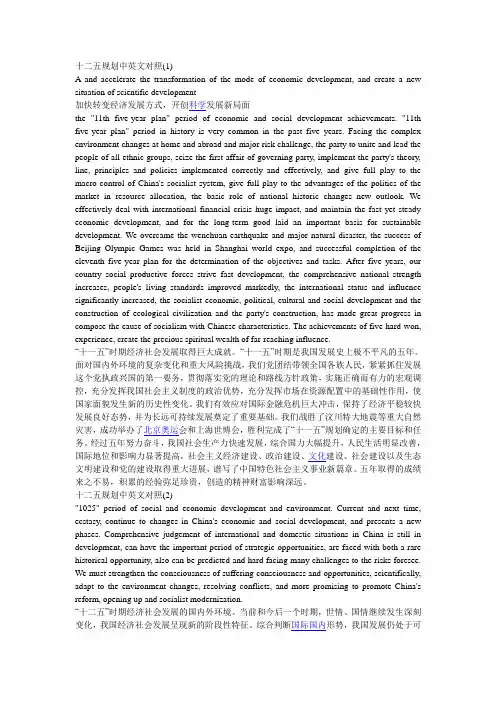
十二五规划中英文对照(1)A and accelerate the transformation of the mode of economic development, and create a new situation of scientific development加快转变经济发展方式,开创科学发展新局面the "11th five-year plan" period of economic and social development achievements. "11th five-year plan" period in history is very common in the past five years. Facing the complex environment changes at home and abroad and major risk challenge, the party to unite and lead the people of all ethnic groups, seize the first affair of governing party, implement the party's theory, line, principles and policies implemented correctly and effectively, and give full play to the macro-control of China's socialist system, give full play to the advantages of the politics of the market in resource allocation, the basic role of national historic changes new outlook. We effectively deal with international financial crisis huge impact, and maintain the fast yet steady economic development, and for the long-term good laid an important basis for sustainable development. We overcame the wenchuan earthquake and major natural disaster, the success of Beijing Olympic Games was held in Shanghai world expo, and successful completion of the eleventh five-year plan for the determination of the objectives and tasks. After five years, our country social productive forces strive fast development, the comprehensive national strength increases, people's living standards improved markedly, the international status and influence significantly increased, the socialist economic, political, cultural and social development and the construction of ecological civilization and the party's construction, has made great progress in compose the cause of socialism with Chinese characteristics. The achievements of five hard-won, experience, create the precious spiritual wealth of far-reaching influence.“十一五”时期经济社会发展取得巨大成就。
2012年2月15日,中共中央办公厅、国务院办公厅近日印发了《国家“十二五”时期文化改革发展规划纲要》,并发出通知,要求各地区各部门结合实际认真贯彻执行。
《国家“十二五”时期文化改革发展规划纲要》“十二五”时期是全面建设小康社会的关键时期,也是促进文化又好又快发展的关键阶段。
为深入贯彻落实党的十七届六中全会精神,深化文化体制改革、推动社会主义文化大发展大繁荣,进一步兴起社会主义文化建设新高潮,努力建设社会主义文化强国,根据《中共中央关于深化文化体制改革、推动社会主义文化大发展大繁荣若干重大问题的决定》和《中华人民共和国国民经济和社会发展第十二个五年规划纲要》,编制本纲要。
序言文化是民族的血脉,是人民的精神家园。
当今世界,文化地位和作用更加凸显,越来越成为民族凝聚力和创造力的重要源泉、越来越成为综合国力竞争的重要因素、越来越成为经济社会发展的重要支撑,丰富精神文化生活越来越成为我国人民的热切愿望。
在新的历史起点上深化文化体制改革、推动社会主义文化大发展大繁荣,关系实现全面建设小康社会奋斗目标,关系坚持和发展中国特色社会主义,关系实现中华民族伟大复兴。
“十一五”时期是我国文化建设的创新发展期。
各地区各部门认真贯彻中央决策部署,解放思想、实事求是、与时俱进、改革创新,推动文化建设不断取得新成就,走出了中国特色社会主义文化发展道路。
中国特色社会主义理论体系广泛普及,全党全国各族人民团结奋斗的共同思想基础不断巩固。
社会主义核心价值体系建设扎实推进,全社会思想道德水平进一步提升。
文化体制改革取得实质性进展,有利于文化科学发展的体制机制初步形成。
公共文化服务体系框架基本建立,服务能力和水平显著提高。
文化产业蓬勃发展,整体规模和实力快速提升。
文化产品创作生产十分活跃,精品不断涌现、市场日益繁荣。
文化遗产保护力度不断加大,优秀民族传统文化进一步弘扬。
文化走出去步伐加快,中华文化的国际竞争力和影响力明显增强。
当前和今后一段时期,我国发展仍处于可以大有作为的重要战略机遇期。
China s Five Plan ´12th YearChallenges for a greener futureLars‐Erik LiljelundjPhase I•First step; the great clean‐upp–Emission reductions from point sources –pollution load to air, water and soil• islands Second step;from problem”islands”to ”continents”–Diffuse pollutant sources–Products–Integrated apporachHow?•Regulations; license, supervision, control •Introduce economic instruments (PPP principle)•Close down counter productive subsidies •Structural changes (old factories, etc.)factories power plants etc)•Regional cooperation•MonitoringPhase IIH li i /h →”i l bl •Holistic/system approach → ”environmental problems are problems generated by the society” →benefits, other policyareas synergies and barriers in connection to •Production –consumption patterns•behaviourHuman •Identify the real driving forces behind environmental degradation•Sustainability in a global context•objectives Policy and targets•From regulations towards more market based mechanismsEnergy•Energy intensity, efficiency, saving and renewables–Regulations; legislation, standards–Efficient →economic instruments→pricemechanisms–”Good and bad” subsidies”G d d b d”b idi•Lot of experiences from other countries and CCICED task forces over the last decadeWorld primary energy demand in theReference Scenario: this is unsustainable!1600018 000M t o e 00012 00014 000Hydro Nuclear Biomass 6 0008 00010 Gas Coal 02 0004 000Oil198019902000201020202030World energy demand expands by 45% between now and 2030 –an average rate of increase of16%year coal accounting for more than a third of the overall rise 1.6%per –with World Energy outlook 2008Pledges in Copenhagen Accord60LowHigh 4050 3.8gP 550Lt 55020302.3P 510L 0101.8Lt 450P 2005202020352050 450Lt 400percent decrase 1990 –2008Energyintensity ‐Swedenand biodiversity Ecosystem•Ecosystem servicesi–Climate change (carbon storage, emissions of GHG etc.) and climate regulation–Water management, flooding, erosion control–Fibre, renewables,p–Biochemicals, pharmaceuticals–Genetical storage–Ecotourism–Non‐monetary valuesecosystemsPressure on•Global meat, fish, and dairy consumption isg ynow causing around 30% of biodiversity loss •80% of agricultural area is currently devoted to meat and dairyproduction•10% of the world’s population consumes 25% of animal protein (fish, meat, and dairy) and world 1970 consumption has doubled since •Renewable resources for energy useHow?•Integrated approach→ terrestrial, limnic,d h→i l li i marine environment•Price on ecosystem services and biodiversity •Cost of action cost of inaction •Conservation → area protection•Long term approachh•Define the framework for sustainable use •Monitoring on different scalesConceptual developmentCircular economyLow Carbon economyGreen economy –Green growthChina•Has a strong economy but is still a developingb i ill d l i country•Trying to find pathways towards sustainability,g p q ye.g. an improved quality of life•Is aware that that the environmental situation of today needs corrections and new approachesU d t d th t th i d f f •Understand that there is a need of more of smart work than hard workOverarchingchallenge谢谢!Thanks for attention!your。
Outline of 12FYP draftPart I: Transforming growth pattern, create a new scenario for scientific development Chapter 1: Development EnvironmentChapter 2: Guiding PrinciplesChapter 3: Main TargetsChapter 4: Policy DirectionPart II: Strengthen and benefit the farmers, accelerating the construction of socialist new countrysideChapter 5: accelerating the development of modern agricultureChapter 6: Expanding the channels for farmer's incomeChapter 7: Improve the rural production and living standardsChapter 8: Improve the institution for rural developmentPart III: Transformation and upgrading, enhancing the competitiveness of industrial coreChapter 9: Improve and promote manufactureChapter 10: Foster and develop strategic emerging sectorsChapter 11: Accelerate the reform of energy production and utilization modeChapter 12: Construct comprehensive transportation systemChapter 13: Comprehensively improve the informationization levelChapter 14: Promote the development of marine economyPart IV: Create an environment to promote big development in service sectorChapter 15: Speeding up the development of service sector related to productionChapter 16: Speeding up the development of service sector related to people's living Chapter 17: Foster a positive environment which could facilitate the development of service sectorPart V: Optimizing the structure, accelerating the coordinated regional development and sound urbanization developmentChapter 18: Implementing the overall strategy on regional developmentChapter 19: Implementing the strategy of major function regionsChapter 20: Actively and steadily promote urbanizationPart VI: Green development, construct energy conservation and environment friendly society Chapter 21: Actively cope with global climate changeChapter 22: Strengthen energy conservation and managementChapter 23: Vigorously develop circular economyChapter 24: Intensify environment protectionChapter 25: Accelerate ecological protection and repairChapter 26: Strengthen the construction of water conservation and disaster prevention and mitigation systemPart VII: Innovation driven, implementing the strategy of reinvigorating the country through science and education and the strategy of strengthening the country through human resource developmentChapter 27: Strengthen the capability of technological innovationChapter 28: Speeding up the reform and development of educationChapter 29: Establish grand high-quality talent teamPart VIII: Improve people's wellbeing, establish and improve basic public service system Chapter 30: Improve basic public serviceChapter 31: Implementing the strategy of 'employment as priority'Chapter 32: Appropriately adjust income and distributionChapter 33: Improve the social security system which covered urban and rural residentsChapter 34: Improve basic health care systemChapter 35: Improve construction of affordable housesChapter 36: Comprehensively carry out population workPart IX: Cure the symptoms and the roots, strengthen and innovate social management Chapter 37: Innovate social management institutionChapter 38: Intensify the autonomy and service function of urban and rural communityChapter 39: Strengthen the construction of social organizationsChapter 40: Improve the mechanism of protecting public interestsChapter 41: Strengthen the construction of public security systemPart X: Inherit and innovate, promoting the big development and prosperous of culture Chapter 42: Improving the civilization and quality of all nationChapter 43: Promote cultural innovationChapter 44: Promote prosperous development of cultural undertaking and cultural industryPart XI: Reform in difficult areas, improving socialism institution of market economy Chapter 45: Adhere and improve basic economic systemChapter 46: Promote administrative reformChapter 47: Accelerate fiscal and taxation system reformChapter 48: Deepen the financial system reformChapter 49: Deepen the reform of price of resource products and fees for environmental protectionPart XII: Mutual beneficial and win-win, improving the opening upChapter 50: Improve regional opening up patternChapter 51: Optimize foreign trade structureChapter 52: Coordinate 'Bring in' and 'Going Out'Chapter 53: Actively participate in global economic governance and regional cooperationPart XIII: Develop democracy; promote the construction of socialism political civilization Chapter 54: Develop socialism democratic politicsChapter 55: Comprehensively promote the construction of legal systemChapter 56: Strengthen efforts to promote clean government and combat corruptionPart XIV: Deepen cooperation; construct the common homeland for Chinese nationChapter 57: Maintain Hong Kong and Macao's long term prosperity and stabilityChapter 58: Promote the peaceful development of cross strait relations and reunification of motherlandPart XV: Civil-military integration, strengthen the construction of national defense and army modernizationChapter 59: Strengthen the construction of national defense and army modernizationChapter 60: Promote the development of civil-military integrationPart XVI: Strengthen implementation, achieve the grand development blueprintChapter 61: Improve the implementing and evaluation mechanismChapter 62: Strengthen the coordinated managementOverview of targets in the 12th Five-year Plan:Part I:Transforming growth pattern,create a new scenario for scientific developmentChapter 1: Development EnvironmentGiven the great achievements of social development that we have attained in the last five years, the 11th Five Year Plan period is indeed extraordinary. In face of the complex changes and major risks both at home and abroad, the whole nation are united. Under the leadership of the Central Committee of the Communist Party of China (CPC), “Strive to Develop” has been attached great importance. Through implementing theories and policies of CPC and conducting the most effective macroeconomic regulation, we fully give full play to the socialist mechanism as well as to the market in terms of allocating resources. As a result, historical changes have occurred to our nation. We have not only effectively addressed the negative impacts caused by the global financial crisis but also maintained a rapid and stable economic development, which has laid a solid foundation for the sustainable development in the future. We successfully held the Beijing Olympic Games and the Shanghai World Expo. We have achieved the major objectives set in the 11th Five Year Plan. With five -year hard work, the national GDP and competitiveness have significantly enhanced. People have enjoyed a relatively high living standard, which has given a boost to China’s international status and influence. Tremendous achievements have been made in various aspects including construction of socialist economy, socialist politics, socialist culture, and ecological civilization. The new chapter of socialism with Chinese characteristics has been written. Having said that, our success does not come easily and the experiences we have gained are precious. The aspirations we have had are profound and lasting.The current world is characterized of continuous complex changes, which may last for a while. Based on the judgment of both domestic and international situations, China is still in an important period of strategic opportunities during which there is a great deal China can achieve, and it is faced with both precious historic opportunities and plenty of foreseeable and unforeseeable risks and challenges. We should strengthen our awareness of the opportunities and challenges ahead. A good understanding of law of development, better adaptation to the environment, appropriate reconciliation of a variety of conflicts can put forward the endeavour of opening-up and reform as well as socialist modernization drive. In face of multi-polarity, deepening economic globalization, new changes in global economic political system, breakthroughs in technological innovation and that international tide remains peace, cooperation and development; China could embrace the general international environment which makes for the nation’s stable development. Meanwhile, international financial crisis still poses its profound impacts on global economy, slowing down the world’s economic growth; the global demand structure also appears salient changes, with competition more intensively focusing on market, resources, talented people, technologies and standards; global issues such as climate change, energy security and food safety are becoming protruding; protectionism in various forms has been increasing. Under the scenario, China’s external international environment has proved to be more complicated. China is to locate its positioning in international economic division of labour and to facilitate international economic cooperation as well as to and create its new advantages in global competition. Domestically speaking, China is experiencing industrialization, informationization, urbanization, marketization and further internationalization, with a stable growth in per capitanational income. China is also undergoing an accelerated transformation of economic structure and a huge potential in market demand, enjoying abundant capital supply, an increase in the capacity of technology and education, an enhancement in the quality of labours and a gradual improvement of infrastructure. Dynamics in structure is conspicuously strengthened; government macro-control ability as well as its capability to handle complicated situations has also been greatly been enhanced. Social security system is getting strengthened along with overall social stability within grasp. China is confident to with its ability and social conditions to promote the development of economic and social development up to a new level as well as to raise the overall national strengthen. However, it is important to have a clear sight of the imbalanced, incompatible and non-sustainable elements within China’s development, which mainly turn out to be a tightened constraint between economic growth on one hand and resources and environment on the other, an imbalance between investment and consumption, a relatively large income disparity, uncompetitive technological innovation ability, unreasonable industrial structure, vulnerable agricultural basis, a gap between rural and urban development, a coexistence of total employment pressure and structural contradiction, a significant increase in social conflicts and a still considerable number of institutional obstacles that restrain scientific development. China needs to wisely judge and accurately grasp the development trend, making full use of various advantageous conditions to efficiently solve the protruding contradictions and issues.Chapter 2: Guiding PrinciplesTo formulate the 12th Five Year Plan, we should hold high the great banner of socialism with Chinese characteristics. Under the guidance of Deng Xiaoping Theory and the important thought of Three Represents, we should comprehensively implement a scientific outlook on development and adjust to the new changes both home and abroad. We should live up to people’s expectation to live a better life by deepening the endeavour of opening up and reform, and improve the social welfare system and people’s livelihood. In order to achieve those goals, the scientific development is the theme while the acceleration of economic growth modes is the cardinal line. Additionally, we should consolidate the progress achieved in tackling the global financial crisis and improve a steady and rapid economic development in the long run as well as promote social harmony. The above-mentioned goals will lay a decisive foundation for building a well-off society in an all aspects.The theme of scientific development is required by the times. It determines the overall situation of our endeavour of opening-up and reform, and the modernization drive. With more than 1.3billion people, China is still and will be on the primary stage of socialism. As the largest developing country in the world, development is the key to solving problems. Currently, adhering to development in China is the main principle, In other words, we should stick to scientific development, pay more attention to people and to the comprehensive and coordinated sustainable development, put a premium on overall planning with due consideration for all concerned, attach more importance to social welfare protection and improvement and enhance social justice. The inevitable way to promote scientific development is to maintain the cardinal line of speeding up the transformation of economic development, which accords well with China’s fundamental realities and the new characteristics of the current developing stage. To accelerate transformation of the mode of economic development is a serious reform in China’s economic and social fields, which must be run through the overall process and various fields in the development of economy and society, to make for a comprehensive, coordinated and sustainable development, to facilitatechanges while developing and further promote development with changes on the way, to finally realize the sound and fast development of both economy and social life. To achieve these goals, the fundamental requirements lie in that:We sill elevate the core competitiveness of manufacturing industry, improving the new and strategic industries, speeding up the development of service industry as well as the primary and the second industries, striking a balance between the urban and rural development, proactively and steadily put forward the urbanization, accelerating the construction of socialist new villages and achieving the coordinated and interactive development among areas. Scientific progress and innovation will support the transformation. Through comprehensively implementing the strategy of rejuvenating our country through science and education and talents, we will give full play to the role of science and human resources. China should upgrade its capabilities in indigenous research and innovation in science, technology and administration, train more innovative talents and improve education for workers. In a word, we will strive to speed up the construction of an innovation country.The "fundamental end" of economic transformation is to improve people's lives, which could only be achieved by improving social welfare system, giving priority to job creation, providing equal public services to every citizen and stepping up reform of the income distribution system, We will unswervingly realize the shared prosperity and bring the benefits to the people.In transforming the economic development mode, the importance of building a resource-saving and environment-friendly society should be stressed to save energy, reduce greenhouse emissions and actively tackle global climate change. We should develop circular economy and low carbon technologies Through striking a balance between economic development and population growth, sustainable development will be enhanced.The endeavour of reform and opening-up will drive the transformation. We should unswervingly push forward reforms in economic, political and social areas. Efforts should be made in building up a mechanism of advantage to scientific development. We should carry out the open-up strategy to achieve outcomes. We are working with the international society to tackling global challenges and share the potential for development.Chapter 3: Main Targets (see excel)Resource conservation and environmental protection targets are striking. We will maintain farmland reserves at 1.818 billion mu (approximately 121,260,600 hectares). We will cut water consumption per unit of value-added industrial output by 30%, and increase the water efficiency coefficient in agricultural irrigation to 0.53. Non-fossil fuel resources will rise to 11.4% of primary energy consumption. Energy consumption per unit of GDP will decrease 16% and CO2 emissions per unit of GDP will decrease 17%. We will make significant reductions in the total emissions of major pollutants: chemical oxygen demand (COD) and SO2 by 8%, ammonia nitrogen and nitrogen oxide by 10%. Forest coverage rate will increase to 21.66% and national forest stocks will increase by 600 million cubic metres.Target 2010 2015 Change over 5 years (%) Forecast orBindingFarmland reserves (billion mu) 1.818 1.818 0 bindingDecrease in water consumption per unit of value-added industrial output (%)30 binding Increase of water efficiency coefficient in agricultural irrigation0.5 0.53 0.03 forecast Increase of non-fossil fuel usage in primary energy consumption (%)8.3 11.4 3.1 binding Decrease in energy consumption per unit of GDP (%)16 binding Decrease in CO2 emissions per unit of GDP (%) 17 bindingChemical Oxygen Demand (COD) 8 Sulphur Dioxide (SO2) 8 Ammonia Nitrogen 10 Total decrease in emissions of major pollutants (%) Nitrous Oxides 10binding Forest coverage rate (%) 20.3621.66 1.3 Forest Increase Forest stock (m³) 137 143 6bindingChapter 4: Policy Direction-Strengthen and improve macro-control. Strengthen the coordination of fiscal, monetary,investment, industrial and land policy, well balance the relationship between economicgrowth, restructure and managing inflation expectancy.-establish long term mechanism of expanding domestic demand. Create positive consumptionenvironment by actively yet steadily accelerating urbanization, implementing the strategy ofemployment as priority, deepening the distribution reform and improving social securitysystem, gradually make the overall size of our domestic market ranks among the largestinternationally.-optimize investment structure. Clear definite the scope of government investment,standardize the investment behaviour of SOEs, encourage private investment, effectivelycontain blind expansion and repeat construction, promote virtuous interaction, combineincrease investment, employment and improve people’s wellbeing, create demand.-simultaneously promote industrialization, urbanization and agricultural modernization.Industry should support agriculture, city should support countryside, consolidate thefoundation for agricultural development, speeding up agricultural modernization.-Promote industrial upgrading by scientific innovation Guide the investment, talents andtechnology flow to enterprises, promote the strategic union of production and R&D, increasethe industrial core competitiveness, promote coordinated development of three industrials inhigher level.-Accelerate coordinated and interactive regional development. In implementing master strategy of regional development and main function development, high priority should be given to the strategy of large-scale development of the western region, fully play the competitive advantage of each region; facilitate the flow of production factors and transition of industries, foster new regional economic engine in the central and western region, increase the coordination of regional development.-Improve the incentive mechanism of energy conservation and emission reduction. Optimize the energy consumption structure, improve the mechanism of pricing and resources product and resource and environmental taxation, and strengthen the related laws, regulations and standard.-Promote the equalization of basic public service. Improve public fiscal system and the social security system and gradually minimize the gaps between urban-rural and regional living standards and public service. Establish and improve the sustainable public service system which suits Chinese development situation, relatively comprehensive and covering both rural and urban areas.-Accelerate the growth of rural and urban income. Improve the first and second distribution, appropriately adjust the distribution relationships between country, enterprises and people, and significantly increase the incomes of low-income group, continuously expanding the middle income group, reserve the enlarging trend of the gaps and strive to realize the synchronization of income and economic growth, remuneration and productivity.-Strengthen and innovate social management. Increase the ability of social management, innovate the system, accelerate the construction of service government, focus to solve the original, basic and foundational problems which impacts the social harmony and stability, maintain the stable, orderly and vitality of society.Part II:Strengthen and benefit the farmers,accelerating the construction of socialist new countryside Chapter 5: accelerating the development of modern agricultureChapter 6: Expanding the channels for farmer's incomeChapter 7: Improve the rural production and living standardsChapter 8: Improve the institution for rural developmentPart III:Transformation and upgrading,enhancing the competitiveness of industrial coreAdhere to the new path of industrialization with Chinese characteristics, adapt to changes of market needs, give play to the comparative advantage of our country’s industries in the global economy in light of the new trend of scientific and technological progress, and develop a modern industry system featuring optimized structure, advanced technology, cleanliness and safety, high added value and large employment capacity.Chapter 9: Improve and promote manufactureOptimize structure, improve varieties and quality, enhance industry supporting capability, eliminate backward production capacity, develop the advanced equipment manufacturing industry, adjust the optimize raw material industries, transform and improve the consumer goods industry, and promoting the enlargement and enhancement of manufacturing industries. Section 1 Promoting the restructuring of key industriesThe equipment manufacturing industry should improve the level of R&D and system integration of basic techniques, basic materials and basic components, strengthen the R&D and industrialization of critical technological equipment, and promote the intellectualization of equipment products. The shipbuilding industry should establish a modern shipbuilding pattern, and develop shipbuilding and supporting equipment with high technical added value in adaptation to new international shipbuilding standards. The automobile industry should strengthen the R&D capability of complete vehicles, realize the technical autonomy of key parts, and improve the level of energy conservation, environmental protection and security technology. The smelting and building material industries should control overall volume expansion strictly, optimize variety structure, and make new progress in product R&D, integrated resources utilization, energy conservation and emission reduction based on domestic demand. The petrochemical industry should explore new paths of diversified development of raw materials, focus on the development of high-end petrochemical products, accelerate the adjustment of fertilizer raw materials, and promote oil quality improvement. The light textile industry should strengthen environmental protection and quality safety, strengthen corporate brand building and improve technological equipment level. The packaging industry should accelerate the development of advanced packaging equipment, new packaging materials and high-end packaging products. The electronic information industry should improve R&D level, enhance the capability to develop basic electronics independently, and be guided toward the higher end of the industry chain. The building industry should extend green buildings and green construction, and focus on the optimization of the structure and service pattern with advanced building techniques, materials and information technology. Strengthen the elimination of backward production capacity, and suppress and channel off excess capacity.Section 2 Optimizing industry layoutOptimize the productivity layout of key industries in light of regional functional positioning, and in consideration of such factors as energy resources, environmental capacity and market space. Major domestic products of energy and mineral resources are to be located in places rich in resources in central and western China with priority, and major projects that utilize imported resources mainly are to be located in coastal and frontier areas with priority. The relocation of urban enterprises of iron and steel, non-ferrous metals and chemicals should be carried out orderly. The layout of crude oil processing capacity should be optimized to promote the integrated development of upstream and downstream industries. Guide the clustering of production factors, and create a number of advanced manufacturing bases with international competitiveness based on key state projects. Develop a number of modern industry clusters with distinctive characteristics, a prominent brand image and a sound service platform using industry chains as a tie and industrial parks as a medium.Section 3 Strengthening the technical improvement of enterprises Formulate policies that support the technical improvement of enterprises, and accelerate the application of new technologies, new materials, new techniques and new equipment to improve traditional industries and market competitiveness. Support enterprises to improve equipment level, optimize production processes, accelerate the elimination of backward technologies and equipment, and improve the overall level of integrated utilization of energy resources. Encourage enterprises to enhance new product development capacity, increase the technology level and added value of products, and accelerate the upgrading of products. Promote the IT-based improvement and upgrading of such aspects as R&D and design, production circulation, and business administration, carry out advanced quality management, and promote the management innovation of enterprises. Build a number of industry technical innovation service platforms.Section 4 Guiding the merger and reorganization of enterprises Stick to market-based operations, give play to the role of enterprises as market players, improve related policies and eliminate institutional barriers. Drive advantaged enterprises to carry out alliance, cross-regional merger and reorganization, and increase industry concentration with focus on automobile, iron and steel, cement, machine building, electrolytic aluminum, rare earth, electronic information and pharmaceutical industries, etc. Promote independent brand building, improve brand value and effects, and accelerate the development of large enterprises with world-famous brands and core competencies.Section 5 Promoting the development of small and medium enterprises (SMEs) Develop SMEs energetically, and improve the system of policies and regulations for SMEs. Cause SMEs to accelerate the transformation of development patterns, strengthen quality and integrity building, and improve product quality and competitiveness. Promote the restructuring of SMEs, and improve the level of specialized division of labor. Guide SMEs to develop in clusters, and improve innovation capability and management level. Create afavorable environment to activate the development of SMEs. Establish a sound financial service and credit guarantee system for SMEs, increase the size and percentage of lending to SMEs, and broaden channels of direct financing. Implement and improve preferential policies on taxation, etc. to relieve the social burden on SMEs.Column 4 Key fields of development of manufacturing01Equipment manufacturingDrive equipment manufacturing from a production-oriented style to a service-oriented style, and promote the development of numerically controlled products,green production and enterprise IT building. Develop equipment required forsuch key fields as new strategic industries and infrastructure. Promote thespecialized production of basic techniques, such as casting, forging, welding,thermal treatment and surface treatment, and improve the level of basic parts andcomponents, such as bearings, gears, dies, hydraulics and automatic controls.02ShipbuildingPromote the upgrading of the three main vessel types of bulk vessel, oil tankerand container vessel in according to new international shipbuilding standards.Improve the ship equipment industry and loading rate. Give priority to thedevelopment of large liquefied natural gas (LNG) and liquefied petroleum gas(LPG) vessels, ocean-going fishing vessels, luxury liners, and other high-tech andhigh-added-value vessels. Accelerate the independent design and manufacture ofmobile marine drilling platforms, floating production systems, marineengineering work ships, auxiliary ships, and key supporting equipment andsystems.03AutomobileBuild a system for principle, production and industrialization innovation. Focuson management and control systems for power batteries, driving motors, andother key parts and power assemblies. Promote high-efficiency internalcombustion machines, high-efficiency driving, light-weight materials andstructures, complete vehicle optimization, ordinary hybrid power technologies,and the energy conservation of automobile products.04Iron and steelFocus on the development of steel for express railway, high-grade non-orientedsilicon steel, high magnetic induction oriented silicon steel, high strengthmachine steel and other key steel varieties. Support such technical developmentefforts as non blast furnace iron making, clean steel production and integratedresources utilization. Focus on the development of energy conservation andemission reduction technologies, such as energy management and control system,high-temperature and high-pressure dry coke quenching, integrated residual heatutilization and desulfurization of sintering flue gas. Accelerate the construction ofraw material bases.05Non-ferrous metalsFocus on the development of key materials required for aviation, spaceflight andelectronic information. Support the extended application of cutting-edge smeltingtechnologies, short and continuous processes, and energy conservation andemission reduction technologies, and encourage the recycling of renewableenergy sources, and the integrated utilization of low-grade minerals, associatedminerals, minerals that are difficult to recover and refine, tailings and wasteresidues.。
附件2:城市公共交通“十二五”发展规划纲要(征求意见稿)交通运输部道路运输司二〇一〇年七月目录一、“十一五”期城市公共交通发展情况 (3)(一)取得的成绩。
(4)(二)存在的问题。
(6)二、“十二五”期城市公共交通发展面临的形势 (8)三、“十二五”期城市公共交通发展的指导思想和原则 (12)(一)指导思想。
(12)(二)基本原则。
(12)四、“十二五”期城市公共交通发展的目标和任务 (13)(一)发展目标。
(13)(二)主要任务。
(14)五、保障措施 (19)(一)健全城市公共交通法规体系。
(19)(二)加强城市公共交通规划的编制。
(20)(三)落实城市公共交通设施用地。
(21)(四)加大公共交通基础设施建设和管理力度。
(21)(五)加大公共交通财政保障力度。
(22)(六)建立规范的公共交通补贴补偿制度。
(23)(七)科学制定城市公共交通票价。
(24)(八)加强公共交通人才保障和科研投入。
(25)(九)加强公共交通发展水平的考核与评价。
(66)城市公共交通是满足人民群众基本出行的社会公益性事业,是交通运输服务业的重要组成部分,与人民群众生产生活息息相关,与城市运行和经济发展密不可分,是一项重大的民生工程。
推进城市公共交通行业健康发展,保证城市公共交通平稳有序运行,对于促进经济社会可持续发展、改善城市人居环境、促进城市文明、保障广大人民群众基本出行权益至关重要。
2004年6月,温家宝总理做出重要批示:“优先发展城市公共交通是符合中国实际的城市发展和交通发展的正确战略思想”。
2009年10月,胡锦涛总书记在考察北京交通工作时指出,要解决城市交通问题,必须充分发挥公共交通的重要作用,为广大群众提供快捷、安全、方便、舒适的公共交通服务,使广大群众愿意乘公交、更多乘公交。
为贯彻落实党中央、国务院的指示精神,加快推进城市公共交通健康、有序发展,根据《公路水路交通运输“十二五”发展规划编制框架》要求,特制定城市公共交通“十二五”发展规划纲要。
英文话题词汇学习:“十四五”规划纲要“十四五”规划:the 14th Five-Year Plan就业:employment就业优先战略:employment-first strategy就业机会:employment opportunities高校毕业生:college graduates农民工:rural migrant workers退役军人:veterans收入:income低收入群体:low-income group中等收入群体:middle-income group人均可支配收入:per capita disposable income教育:education高质量教育体系:high-quality education system教育改革:educational reforms提质:to raise the quality扩容:to expand the capacity劳动年龄人口:working-age population医疗:healthcare健康中国:Healthy China公共卫生体系:public health system全民健身运动:public fitness activities人均预期寿命:average life expectancy医保制度:medical insurance system医疗救助制度:medical aid system重大疾病:major diseases养老:elderly care人口老龄化:population aging法定退休年龄:statutory retirement age多层次社会保障体系:multi-tiered social security system 基本养老保险:basic old-age insurance社会救助:social assistance慈善制度:charity system托育:childcare每千人口:per 1,000 population婴幼儿托位数:the number of pupil places for infants。
中华人民共和国国民经济和社会发展第十二个五年规划纲要第一篇转变方式开创科学发展新局面1.坚持把经济结构战略性调整作为加快转变经济发展方式的主攻方向。
构建扩大内需长效机制,促进经济增长向依靠消费、投资、出口协调拉动转变。
加强农业基础地位,提升制造业核心竞争力,发展战略性新兴产业,加快发展服务业,促进经济增长向依靠第一、第二、第三产业协同带动转变。
统筹城乡发展,积极稳妥推进城镇化,加快推进社会主义新农村建设,促进区域良性互动、协调发展。
2.坚持把科技进步和创新作为加快转变经济发展方式的重要支撑。
深入实施科教兴国战略和人才强国战略,充分发挥科技第一生产力和人才第一资源作用,提高教育现代化水平,增强自主创新能力,壮大创新人才队伍,推动发展向主要依靠科技进步、劳动者素质提高、管理创新转变,加快建设创新型国家。
3.坚持把保障和改善民生作为加快转变经济发展方式的根本出发点和落脚点。
完善保障和改善民生的制度安排,把促进就业放在经济社会发展优先位置,加快发展各项社会事业,推进基本公共服务均等化,加大收入分配调节力度,坚定不移走共同富裕道路,使发展成果惠及全体人民。
4.坚持把建设资源节约型、环境友好型社会作为加快转变经济发展方式的重要着力点。
深入贯彻节约资源和保护环境基本国策,节约能源,降低温室气体排放强度,发展循环经济,推广低碳技术,积极应对全球气候变化,促进经济社会发展与人口资源环境相协调,走可持续发展之路。
5.坚持把改革开放作为加快转变经济发展方式的强大动力。
坚定推进经济、政治、文化、社会等领域改革,加快构建有利于科学发展的体制机制。
实施互利共赢的开放战略,与国际社会共同应对全球性挑战、共同分享发展机遇。
第二篇强农惠农加快社会主义新农村建设第五章加快发展现代农业第一节增强粮食安全保障能力严格保护耕地,加快农村土地整理复垦。
加大粮食主产区投入和利益补偿,加强以农田水利设施为基础的田间工程建设,改造中低产田,大规模建设旱涝保收高标准农田。
Outline of 12FYP draftPart I: Transforming growth pattern, create a new scenario for scientific development Chapter 1: Development EnvironmentChapter 2: Guiding PrinciplesChapter 3: Main TargetsChapter 4: Policy DirectionPart II: Strengthen and benefit the farmers, accelerating the construction of socialist new countrysideChapter 5: accelerating the development of modern agricultureChapter 6: Expanding the channels for farmer's incomeChapter 7: Improve the rural production and living standardsChapter 8: Improve the institution for rural developmentPart III: Transformation and upgrading, enhancing the competitiveness of industrial coreChapter 9: Improve and promote manufactureChapter 10: Foster and develop strategic emerging sectorsChapter 11: Accelerate the reform of energy production and utilization modeChapter 12: Construct comprehensive transportation systemChapter 13: Comprehensively improve the informationization levelChapter 14: Promote the development of marine economyPart IV: Create an environment to promote big development in service sectorChapter 15: Speeding up the development of service sector related to productionChapter 16: Speeding up the development of service sector related to people's living Chapter 17: Foster a positive environment which could facilitate the development of service sectorPart V: Optimizing the structure, accelerating the coordinated regional development and sound urbanization developmentChapter 18: Implementing the overall strategy on regional developmentChapter 19: Implementing the strategy of major function regionsChapter 20: Actively and steadily promote urbanizationPart VI: Green development, construct energy conservation and environment friendly society Chapter 21: Actively cope with global climate changeChapter 22: Strengthen energy conservation and managementChapter 23: Vigorously develop circular economyChapter 24: Intensify environment protectionChapter 25: Accelerate ecological protection and repairChapter 26: Strengthen the construction of water conservation and disaster prevention and mitigation systemPart VII: Innovation driven, implementing the strategy of reinvigorating the country through science and education and the strategy of strengthening the country through human resource developmentChapter 27: Strengthen the capability of technological innovationChapter 28: Speeding up the reform and development of educationChapter 29: Establish grand high-quality talent teamPart VIII: Improve people's wellbeing, establish and improve basic public service system Chapter 30: Improve basic public serviceChapter 31: Implementing the strategy of 'employment as priority'Chapter 32: Appropriately adjust income and distributionChapter 33: Improve the social security system which covered urban and rural residentsChapter 34: Improve basic health care systemChapter 35: Improve construction of affordable housesChapter 36: Comprehensively carry out population workPart IX: Cure the symptoms and the roots, strengthen and innovate social management Chapter 37: Innovate social management institutionChapter 38: Intensify the autonomy and service function of urban and rural communityChapter 39: Strengthen the construction of social organizationsChapter 40: Improve the mechanism of protecting public interestsChapter 41: Strengthen the construction of public security systemPart X: Inherit and innovate, promoting the big development and prosperous of culture Chapter 42: Improving the civilization and quality of all nationChapter 43: Promote cultural innovationChapter 44: Promote prosperous development of cultural undertaking and cultural industryPart XI: Reform in difficult areas, improving socialism institution of market economy Chapter 45: Adhere and improve basic economic systemChapter 46: Promote administrative reformChapter 47: Accelerate fiscal and taxation system reformChapter 48: Deepen the financial system reformChapter 49: Deepen the reform of price of resource products and fees for environmental protectionPart XII: Mutual beneficial and win-win, improving the opening upChapter 50: Improve regional opening up patternChapter 51: Optimize foreign trade structureChapter 52: Coordinate 'Bring in' and 'Going Out'Chapter 53: Actively participate in global economic governance and regional cooperationPart XIII: Develop democracy; promote the construction of socialism political civilization Chapter 54: Develop socialism democratic politicsChapter 55: Comprehensively promote the construction of legal systemChapter 56: Strengthen efforts to promote clean government and combat corruptionPart XIV: Deepen cooperation; construct the common homeland for Chinese nationChapter 57: Maintain Hong Kong and Macao's long term prosperity and stabilityChapter 58: Promote the peaceful development of cross strait relations and reunification of motherlandPart XV: Civil-military integration, strengthen the construction of national defense and army modernizationChapter 59: Strengthen the construction of national defense and army modernizationChapter 60: Promote the development of civil-military integrationPart XVI: Strengthen implementation, achieve the grand development blueprintChapter 61: Improve the implementing and evaluation mechanismChapter 62: Strengthen the coordinated managementOverview of targets in the 12th Five-year Plan:Part I:Transforming growth pattern,create a new scenario for scientific developmentChapter 1: Development EnvironmentGiven the great achievements of social development that we have attained in the last five years, the 11th Five Year Plan period is indeed extraordinary. In face of the complex changes and major risks both at home and abroad, the whole nation are united. Under the leadership of the Central Committee of the Communist Party of China (CPC), “Strive to Develop” has been attached great importance. Through implementing theories and policies of CPC and conducting the most effective macroeconomic regulation, we fully give full play to the socialist mechanism as well as to the market in terms of allocating resources. As a result, historical changes have occurred to our nation. We have not only effectively addressed the negative impacts caused by the global financial crisis but also maintained a rapid and stable economic development, which has laid a solid foundation for the sustainable development in the future. We successfully held the Beijing Olympic Games and the Shanghai World Expo. We have achieved the major objectives set in the 11th Five Year Plan. With five -year hard work, the national GDP and competitiveness have significantly enhanced. People have enjoyed a relatively high living standard, which has given a boost to China’s international status and influence. Tremendous achievements have been made in various aspects including construction of socialist economy, socialist politics, socialist culture, and ecological civilization. The new chapter of socialism with Chinese characteristics has been written. Having said that, our success does not come easily and the experiences we have gained are precious. The aspirations we have had are profound and lasting.The current world is characterized of continuous complex changes, which may last for a while. Based on the judgment of both domestic and international situations, China is still in an important period of strategic opportunities during which there is a great deal China can achieve, and it is faced with both precious historic opportunities and plenty of foreseeable and unforeseeable risks and challenges. We should strengthen our awareness of the opportunities and challenges ahead. A good understanding of law of development, better adaptation to the environment, appropriate reconciliation of a variety of conflicts can put forward the endeavour of opening-up and reform as well as socialist modernization drive. In face of multi-polarity, deepening economic globalization, new changes in global economic political system, breakthroughs in technological innovation and that international tide remains peace, cooperation and development; China could embrace the general international environment which makes for the nation’s stable development. Meanwhile, international financial crisis still poses its profound impacts on global economy, slowing down the world’s economic growth; the global demand structure also appears salient changes, with competition more intensively focusing on market, resources, talented people, technologies and standards; global issues such as climate change, energy security and food safety are becoming protruding; protectionism in various forms has been increasing. Under the scenario, China’s external international environment has proved to be more complicated. China is to locate its positioning in international economic division of labour and to facilitate international economic cooperation as well as to and create its new advantages in global competition. Domestically speaking, China is experiencing industrialization, informationization, urbanization, marketization and further internationalization, with a stable growth in per capitanational income. China is also undergoing an accelerated transformation of economic structure and a huge potential in market demand, enjoying abundant capital supply, an increase in the capacity of technology and education, an enhancement in the quality of labours and a gradual improvement of infrastructure. Dynamics in structure is conspicuously strengthened; government macro-control ability as well as its capability to handle complicated situations has also been greatly been enhanced. Social security system is getting strengthened along with overall social stability within grasp. China is confident to with its ability and social conditions to promote the development of economic and social development up to a new level as well as to raise the overall national strengthen. However, it is important to have a clear sight of the imbalanced, incompatible and non-sustainable elements within China’s development, which mainly turn out to be a tightened constraint between economic growth on one hand and resources and environment on the other, an imbalance between investment and consumption, a relatively large income disparity, uncompetitive technological innovation ability, unreasonable industrial structure, vulnerable agricultural basis, a gap between rural and urban development, a coexistence of total employment pressure and structural contradiction, a significant increase in social conflicts and a still considerable number of institutional obstacles that restrain scientific development. China needs to wisely judge and accurately grasp the development trend, making full use of various advantageous conditions to efficiently solve the protruding contradictions and issues.Chapter 2: Guiding PrinciplesTo formulate the 12th Five Year Plan, we should hold high the great banner of socialism with Chinese characteristics. Under the guidance of Deng Xiaoping Theory and the important thought of Three Represents, we should comprehensively implement a scientific outlook on development and adjust to the new changes both home and abroad. We should live up to people’s expectation to live a better life by deepening the endeavour of opening up and reform, and improve the social welfare system and people’s livelihood. In order to achieve those goals, the scientific development is the theme while the acceleration of economic growth modes is the cardinal line. Additionally, we should consolidate the progress achieved in tackling the global financial crisis and improve a steady and rapid economic development in the long run as well as promote social harmony. The above-mentioned goals will lay a decisive foundation for building a well-off society in an all aspects.The theme of scientific development is required by the times. It determines the overall situation of our endeavour of opening-up and reform, and the modernization drive. With more than 1.3billion people, China is still and will be on the primary stage of socialism. As the largest developing country in the world, development is the key to solving problems. Currently, adhering to development in China is the main principle, In other words, we should stick to scientific development, pay more attention to people and to the comprehensive and coordinated sustainable development, put a premium on overall planning with due consideration for all concerned, attach more importance to social welfare protection and improvement and enhance social justice. The inevitable way to promote scientific development is to maintain the cardinal line of speeding up the transformation of economic development, which accords well with China’s fundamental realities and the new characteristics of the current developing stage. To accelerate transformation of the mode of economic development is a serious reform in China’s economic and social fields, which must be run through the overall process and various fields in the development of economy and society, to make for a comprehensive, coordinated and sustainable development, to facilitatechanges while developing and further promote development with changes on the way, to finally realize the sound and fast development of both economy and social life. To achieve these goals, the fundamental requirements lie in that:We sill elevate the core competitiveness of manufacturing industry, improving the new and strategic industries, speeding up the development of service industry as well as the primary and the second industries, striking a balance between the urban and rural development, proactively and steadily put forward the urbanization, accelerating the construction of socialist new villages and achieving the coordinated and interactive development among areas. Scientific progress and innovation will support the transformation. Through comprehensively implementing the strategy of rejuvenating our country through science and education and talents, we will give full play to the role of science and human resources. China should upgrade its capabilities in indigenous research and innovation in science, technology and administration, train more innovative talents and improve education for workers. In a word, we will strive to speed up the construction of an innovation country.The "fundamental end" of economic transformation is to improve people's lives, which could only be achieved by improving social welfare system, giving priority to job creation, providing equal public services to every citizen and stepping up reform of the income distribution system, We will unswervingly realize the shared prosperity and bring the benefits to the people.In transforming the economic development mode, the importance of building a resource-saving and environment-friendly society should be stressed to save energy, reduce greenhouse emissions and actively tackle global climate change. We should develop circular economy and low carbon technologies Through striking a balance between economic development and population growth, sustainable development will be enhanced.The endeavour of reform and opening-up will drive the transformation. We should unswervingly push forward reforms in economic, political and social areas. Efforts should be made in building up a mechanism of advantage to scientific development. We should carry out the open-up strategy to achieve outcomes. We are working with the international society to tackling global challenges and share the potential for development.Chapter 3: Main Targets (see excel)Resource conservation and environmental protection targets are striking. We will maintain farmland reserves at 1.818 billion mu (approximately 121,260,600 hectares). We will cut water consumption per unit of value-added industrial output by 30%, and increase the water efficiency coefficient in agricultural irrigation to 0.53. Non-fossil fuel resources will rise to 11.4% of primary energy consumption. Energy consumption per unit of GDP will decrease 16% and CO2 emissions per unit of GDP will decrease 17%. We will make significant reductions in the total emissions of major pollutants: chemical oxygen demand (COD) and SO2 by 8%, ammonia nitrogen and nitrogen oxide by 10%. Forest coverage rate will increase to 21.66% and national forest stocks will increase by 600 million cubic metres.Target 2010 2015 Change over 5 years (%) Forecast orBindingFarmland reserves (billion mu) 1.818 1.818 0 bindingDecrease in water consumption per unit of value-added industrial output (%)30 binding Increase of water efficiency coefficient in agricultural irrigation0.5 0.53 0.03 forecast Increase of non-fossil fuel usage in primary energy consumption (%)8.3 11.4 3.1 binding Decrease in energy consumption per unit of GDP (%)16 binding Decrease in CO2 emissions per unit of GDP (%) 17 bindingChemical Oxygen Demand (COD) 8 Sulphur Dioxide (SO2) 8 Ammonia Nitrogen 10 Total decrease in emissions of major pollutants (%) Nitrous Oxides 10binding Forest coverage rate (%) 20.3621.66 1.3 Forest Increase Forest stock (m³) 137 143 6bindingChapter 4: Policy Direction-Strengthen and improve macro-control. Strengthen the coordination of fiscal, monetary,investment, industrial and land policy, well balance the relationship between economicgrowth, restructure and managing inflation expectancy.-establish long term mechanism of expanding domestic demand. Create positive consumptionenvironment by actively yet steadily accelerating urbanization, implementing the strategy ofemployment as priority, deepening the distribution reform and improving social securitysystem, gradually make the overall size of our domestic market ranks among the largestinternationally.-optimize investment structure. Clear definite the scope of government investment,standardize the investment behaviour of SOEs, encourage private investment, effectivelycontain blind expansion and repeat construction, promote virtuous interaction, combineincrease investment, employment and improve people’s wellbeing, create demand.-simultaneously promote industrialization, urbanization and agricultural modernization.Industry should support agriculture, city should support countryside, consolidate thefoundation for agricultural development, speeding up agricultural modernization.-Promote industrial upgrading by scientific innovation Guide the investment, talents andtechnology flow to enterprises, promote the strategic union of production and R&D, increasethe industrial core competitiveness, promote coordinated development of three industrials inhigher level.-Accelerate coordinated and interactive regional development. In implementing master strategy of regional development and main function development, high priority should be given to the strategy of large-scale development of the western region, fully play the competitive advantage of each region; facilitate the flow of production factors and transition of industries, foster new regional economic engine in the central and western region, increase the coordination of regional development.-Improve the incentive mechanism of energy conservation and emission reduction. Optimize the energy consumption structure, improve the mechanism of pricing and resources product and resource and environmental taxation, and strengthen the related laws, regulations and standard.-Promote the equalization of basic public service. Improve public fiscal system and the social security system and gradually minimize the gaps between urban-rural and regional living standards and public service. Establish and improve the sustainable public service system which suits Chinese development situation, relatively comprehensive and covering both rural and urban areas.-Accelerate the growth of rural and urban income. Improve the first and second distribution, appropriately adjust the distribution relationships between country, enterprises and people, and significantly increase the incomes of low-income group, continuously expanding the middle income group, reserve the enlarging trend of the gaps and strive to realize the synchronization of income and economic growth, remuneration and productivity.-Strengthen and innovate social management. Increase the ability of social management, innovate the system, accelerate the construction of service government, focus to solve the original, basic and foundational problems which impacts the social harmony and stability, maintain the stable, orderly and vitality of society.Part II:Strengthen and benefit the farmers,accelerating the construction of socialist new countryside Chapter 5: accelerating the development of modern agricultureChapter 6: Expanding the channels for farmer's incomeChapter 7: Improve the rural production and living standardsChapter 8: Improve the institution for rural developmentPart III:Transformation and upgrading,enhancing the competitiveness of industrial coreAdhere to the new path of industrialization with Chinese characteristics, adapt to changes of market needs, give play to the comparative advantage of our country’s industries in the global economy in light of the new trend of scientific and technological progress, and develop a modern industry system featuring optimized structure, advanced technology, cleanliness and safety, high added value and large employment capacity.Chapter 9: Improve and promote manufactureOptimize structure, improve varieties and quality, enhance industry supporting capability, eliminate backward production capacity, develop the advanced equipment manufacturing industry, adjust the optimize raw material industries, transform and improve the consumer goods industry, and promoting the enlargement and enhancement of manufacturing industries. Section 1 Promoting the restructuring of key industriesThe equipment manufacturing industry should improve the level of R&D and system integration of basic techniques, basic materials and basic components, strengthen the R&D and industrialization of critical technological equipment, and promote the intellectualization of equipment products. The shipbuilding industry should establish a modern shipbuilding pattern, and develop shipbuilding and supporting equipment with high technical added value in adaptation to new international shipbuilding standards. The automobile industry should strengthen the R&D capability of complete vehicles, realize the technical autonomy of key parts, and improve the level of energy conservation, environmental protection and security technology. The smelting and building material industries should control overall volume expansion strictly, optimize variety structure, and make new progress in product R&D, integrated resources utilization, energy conservation and emission reduction based on domestic demand. The petrochemical industry should explore new paths of diversified development of raw materials, focus on the development of high-end petrochemical products, accelerate the adjustment of fertilizer raw materials, and promote oil quality improvement. The light textile industry should strengthen environmental protection and quality safety, strengthen corporate brand building and improve technological equipment level. The packaging industry should accelerate the development of advanced packaging equipment, new packaging materials and high-end packaging products. The electronic information industry should improve R&D level, enhance the capability to develop basic electronics independently, and be guided toward the higher end of the industry chain. The building industry should extend green buildings and green construction, and focus on the optimization of the structure and service pattern with advanced building techniques, materials and information technology. Strengthen the elimination of backward production capacity, and suppress and channel off excess capacity.Section 2 Optimizing industry layoutOptimize the productivity layout of key industries in light of regional functional positioning, and in consideration of such factors as energy resources, environmental capacity and market space. Major domestic products of energy and mineral resources are to be located in places rich in resources in central and western China with priority, and major projects that utilize imported resources mainly are to be located in coastal and frontier areas with priority. The relocation of urban enterprises of iron and steel, non-ferrous metals and chemicals should be carried out orderly. The layout of crude oil processing capacity should be optimized to promote the integrated development of upstream and downstream industries. Guide the clustering of production factors, and create a number of advanced manufacturing bases with international competitiveness based on key state projects. Develop a number of modern industry clusters with distinctive characteristics, a prominent brand image and a sound service platform using industry chains as a tie and industrial parks as a medium.Section 3 Strengthening the technical improvement of enterprises Formulate policies that support the technical improvement of enterprises, and accelerate the application of new technologies, new materials, new techniques and new equipment to improve traditional industries and market competitiveness. Support enterprises to improve equipment level, optimize production processes, accelerate the elimination of backward technologies and equipment, and improve the overall level of integrated utilization of energy resources. Encourage enterprises to enhance new product development capacity, increase the technology level and added value of products, and accelerate the upgrading of products. Promote the IT-based improvement and upgrading of such aspects as R&D and design, production circulation, and business administration, carry out advanced quality management, and promote the management innovation of enterprises. Build a number of industry technical innovation service platforms.Section 4 Guiding the merger and reorganization of enterprises Stick to market-based operations, give play to the role of enterprises as market players, improve related policies and eliminate institutional barriers. Drive advantaged enterprises to carry out alliance, cross-regional merger and reorganization, and increase industry concentration with focus on automobile, iron and steel, cement, machine building, electrolytic aluminum, rare earth, electronic information and pharmaceutical industries, etc. Promote independent brand building, improve brand value and effects, and accelerate the development of large enterprises with world-famous brands and core competencies.Section 5 Promoting the development of small and medium enterprises (SMEs) Develop SMEs energetically, and improve the system of policies and regulations for SMEs. Cause SMEs to accelerate the transformation of development patterns, strengthen quality and integrity building, and improve product quality and competitiveness. Promote the restructuring of SMEs, and improve the level of specialized division of labor. Guide SMEs to develop in clusters, and improve innovation capability and management level. Create afavorable environment to activate the development of SMEs. Establish a sound financial service and credit guarantee system for SMEs, increase the size and percentage of lending to SMEs, and broaden channels of direct financing. Implement and improve preferential policies on taxation, etc. to relieve the social burden on SMEs.Column 4 Key fields of development of manufacturing01Equipment manufacturingDrive equipment manufacturing from a production-oriented style to a service-oriented style, and promote the development of numerically controlled products,green production and enterprise IT building. Develop equipment required forsuch key fields as new strategic industries and infrastructure. Promote thespecialized production of basic techniques, such as casting, forging, welding,thermal treatment and surface treatment, and improve the level of basic parts andcomponents, such as bearings, gears, dies, hydraulics and automatic controls.02ShipbuildingPromote the upgrading of the three main vessel types of bulk vessel, oil tankerand container vessel in according to new international shipbuilding standards.Improve the ship equipment industry and loading rate. Give priority to thedevelopment of large liquefied natural gas (LNG) and liquefied petroleum gas(LPG) vessels, ocean-going fishing vessels, luxury liners, and other high-tech andhigh-added-value vessels. Accelerate the independent design and manufacture ofmobile marine drilling platforms, floating production systems, marineengineering work ships, auxiliary ships, and key supporting equipment andsystems.03AutomobileBuild a system for principle, production and industrialization innovation. Focuson management and control systems for power batteries, driving motors, andother key parts and power assemblies. Promote high-efficiency internalcombustion machines, high-efficiency driving, light-weight materials andstructures, complete vehicle optimization, ordinary hybrid power technologies,and the energy conservation of automobile products.04Iron and steelFocus on the development of steel for express railway, high-grade non-orientedsilicon steel, high magnetic induction oriented silicon steel, high strengthmachine steel and other key steel varieties. Support such technical developmentefforts as non blast furnace iron making, clean steel production and integratedresources utilization. Focus on the development of energy conservation andemission reduction technologies, such as energy management and control system,high-temperature and high-pressure dry coke quenching, integrated residual heatutilization and desulfurization of sintering flue gas. Accelerate the construction ofraw material bases.05Non-ferrous metalsFocus on the development of key materials required for aviation, spaceflight andelectronic information. Support the extended application of cutting-edge smeltingtechnologies, short and continuous processes, and energy conservation andemission reduction technologies, and encourage the recycling of renewableenergy sources, and the integrated utilization of low-grade minerals, associatedminerals, minerals that are difficult to recover and refine, tailings and wasteresidues.。